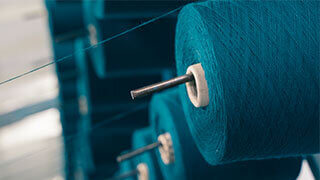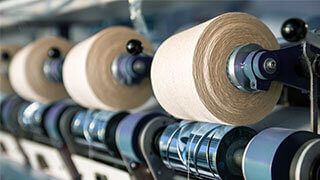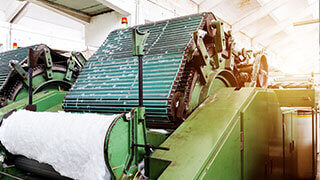Yarn Spinning: Fiber Preparation
Drawing
Drawing’s main purpose is to further align and parallel the semi-oriented fiber from carding. In accomplishing this, blending (or doubling) is also achieved. From 6 to 8 card slivers are combined to be fed to the initial drawing process, sometimes called breaker drawing.
A series of pairs of rollers are used to reduce the multiple slivers being fed back down to the approximate weight of one sliver. These roller pairs consist of one rubber-covered top roller and one fluted steel bottom roller. Spring or air-generated pressure is used to hold the slivers firmly.
There are surface speed differences from the back pair of top and bottom rolls to the front set, with the back pair turning more slowly and gradually building in speed through to the front set. This mechanical speed difference, and the slipping action imparted to the gripped fibers, is called draft or drafting. This is where the drawing process gets its name. The machine draws out the slivers being fed and reduces their total weight back down to the approximate weight of one sliver. In doing this, the trailing ends of the gripped fibers, which may not be completely straight, are straightened out by the slipping and pulling action imparted to them.
As the drafted fiber web exits from the front set of drafting rolls, it is condensed back into sliver form using a trumpet-like device and the resulting sliver is coiled into a can. Once again, this is for temporary storage and for transport to the next process. Depending on what spinning system will be employed, the end product, and other process considerations, the output sliver from breaker drawing may be drawn once more (called finisher drawing) or it may be used directly for the spinning process. This is the point that the breaker-drawn sliver may also be directed to the combing process.
Combing
Combing removes short fibers from the yarn-making process. Depending on the cotton fiber being combed, and the settings of the comber itself, “short” can have more than one meaning, but generally, it means fibers that are half an inch or less in length.
The percentage of these fibers removed can vary greatly, again, depending on the cotton being used and the settings of the comber. The combing process starts by preparing what is known as a lap. This is simply a number of individual, once-drawn slivers that are wound in a ribbon-like fashion onto a spool. This wound lap becomes the input for the combing process.
For each combing cycle, a measured amount of the lap is fed out and held fast for the pass of the half-lap. The half-lap is a wire or needle-covered section mounted on a rotating shaft that passes its teeth or needles through the held beard—the measured lap that has been fed out and held fast. The fibers that are not held fast are removed by the half-lap and collected as waste. These short fibers may be recycled and used elsewhere in a less critical yarn. The combed webs are condensed back into sliver and coiled into a can for temporary storage and transport to subsequent processing.
The reasons for combing vary greatly depending on the end product but generally, it is done to increase the yarn count range of the material being processed. A finer yarn can be made from combed cotton which tends to result in an end product with extra sheen, drape, and hand. Combed yarns and the resulting products tend to be softer and yield more durability. From an engineering standpoint, combing may be required for some yarn counts and some end product performance standards. For other end products, it may just be a price point decision.
Roving
The roving process is a preparatory process used only for ring spinning. Finisher-drawn carded or combed slivers are fed into a simple roller drafting system where the linear weight is reduced to a size that is optimum for the yarn count to be spun. Since the linear mass is now drafted to a very lightweight, some twist insertion is also necessary to give the roving enough integrity to be pulled from the bobbin on the ring-spinning frame. The roving is wound in a precise manner onto a bobbin that varies in length from around one foot to over 15 inches. A full bobbin can weigh over 5 pounds.
TERMS TO KNOW (click to flip)
The process in yarn manufacturing in which a group of slivers are drafted by passing through a series of paired…
view in glossaryProcessing of cotton fiber through a combing machine that is designed to remove short fiber from the sliver/fiber mix.
view in glossaryThe preparation process used only for ring spinning. The resultant bobbin is the feed for the ring-spinning frame.
view in glossary

